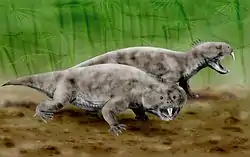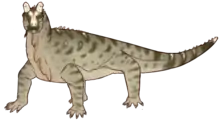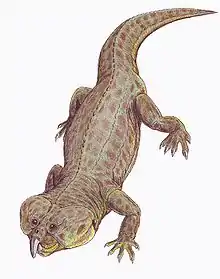Oryctorhynchus
Oryctorhynchus is an extinct genus of rhynchosaur from the Late Triassic (Carnian-Norian)-aged Wolfville Formation of Nova Scotia, Canada. The type species, O. bairdi, was named and described in 2020.[1] It was originally seen as a species of Hyperodapedon until 2020.
| Oryctorhynchus | |
|---|---|
 | |
| Skeletal | |
| Scientific classification | |
| Kingdom: | Animalia |
| Phylum: | Chordata |
| Class: | Reptilia |
| Order: | †Rhynchosauria |
| Family: | †Rhynchosauridae |
| Subfamily: | †Hyperodapedontinae |
| Genus: | †Oryctorhynchus Sues, Fitch & Whatley, 2020 |
| Type species | |
| †Oryctorhynchus bairdi Sues, Fitch & Whatley, 2020 | |
Discovery and naming
The holotype was discovered in the Wolfville Formation; its earliest known mention is by Baird (1963).[2] Shortly after,[3] it was informally named the "Nova Scotia Hyperodapedon" (H. sp.) by Robin Whatley. It was briefly described by Michael Benton (1983) also as a species of Hyperodapedon.[4] The genus was not recognised as a distinct taxon until it was named in 2020.[1]
The holotype, NSM018GFF009.003, consists of a partial jaw and several skull fragments including the rostrum and skull roof.[1][4]
Classification

Sues et al. (2020) placed Oryctorhynchus as the sister species to Hyperodapedon and an unnamed hyperodapedontine taxon from Wyoming.[1]
Paleoecology
Ornithorhynchus is from the Wolfville Formation (Upper Wolfville Member; Fundy Basin), which probably corresponds to the Popo Agie Formation. The age of the Upper Wolfville Member is unclear; it either dates from the latest Carnian? - earliest Norian? or the late Carnian (~230 Ma).[5]
It would have coexisted with Acadiella,[6] Arctotraversodon,[7] Arctosuchus buceros (?),[8] Haligonia,[6] Scoloparia[6] and Teraterpeton.[9]
References
- Hans-Dieter Sues; Adam J. Fitch; Robin L. Whatley (2020). "A new rhynchosaur (Reptilia, Archosauromorpha) from the Upper Triassic of eastern North America". Journal of Vertebrate Paleontology. Online edition: e1771568. doi:10.1080/02724634.2020.1771568.
- Baird, Donald (1963). "Fossil Footprints or Stump Holes?". Transactions of the Kansas Academy of Science (1903-). 66 (3): 397–400. doi:10.2307/3626532. ISSN 0022-8443. JSTOR 3626532.
- Hopson, J.A. (1984). Late Triassic traversodont cynodonts from Nova Scotia and southern Africa. Palaeontologia Africana Vol. 25; 181-201.
- Benton, M.J. 1983. The Triassic reptile Hyperodapedon from Elgin: functional morphology and relationships. Philosophical Transactions of the Royal Society of London B 302: 605-717.
- Lucas, Spencer G.; Heckert, Andrew B.; Fraser, Nicholas C.; Huber, Philip (1999-10-21). "Aetosaurus from the Upper Triassic of Great Britain and its biochronological significance". Neues Jahrbuch für Geologie und Paläontologie - Monatshefte. 1999 (9): 568–576. doi:10.1127/njgpm/1999/1999/568. ISSN 0028-3630.
- H.-D. Sues and D. Baird. 1998. Procolophonidae (Reptilia: Parareptilia) from the Upper Triassic Wolfville Formation of Nova Scotia, Canada. Journal of Vertebrate Paleontology 18(3):525-532
- Sues, H.-D.; Hopson, J.A.; Shubin, N.H. (1992). "Affinities of ?Scalenodontoides plemmyridon Hopson, 1984 (Synapsida: Cynodontia) from the Upper Triassic of Nova Scotia". Journal of Vertebrate Paleontology. 12 (2): 168–17. doi:10.1080/02724634.1992.10011447.
- The main groups of non-mammalian synapsids at Mikko's Phylogeny Archive
- Sues, H.-D. (2003). "An unusual new archosauromorph reptile from the Upper Triassic Wolfville Formation of Nova Scotia". Canadian Journal of Earth Sciences. 40 (4): 635–649. doi:10.1139/e02-048.






